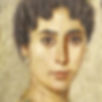Encaustic
Encaustic (wax painting) originates in Greco-Roman antiquity and is therefore much older than oil painting. The Egyptians used it to create mummy portraits, which can still be admired in museums today. The Greeks used encaustics to protect their ships from salt water and decorate them.
In encaustic painting, organic materials are used: hot beeswax is mixed with dammar, a tree resin. Natural pigments are then added to create the various colors. These are applied in liquid form to a usually wooden base and then melted and fired with a gas burner (“encaustic” comes from the ancient Greek ἐγκαυστική [τέχνη] énkaustikē [téchnē], i.e. “the art of making fired paintings”).
In this process, up to 40 layers of wax are applied on top of each other, giving the paintings enormous depth and a beautiful sheen. When using relatively cold wax, structures can be added and exciting effects can also be achieved by engraving or scratching. Wax painting can also be combined with oil sticks, pastels, inks, and shellac - the technique is incredibly fascinating.











